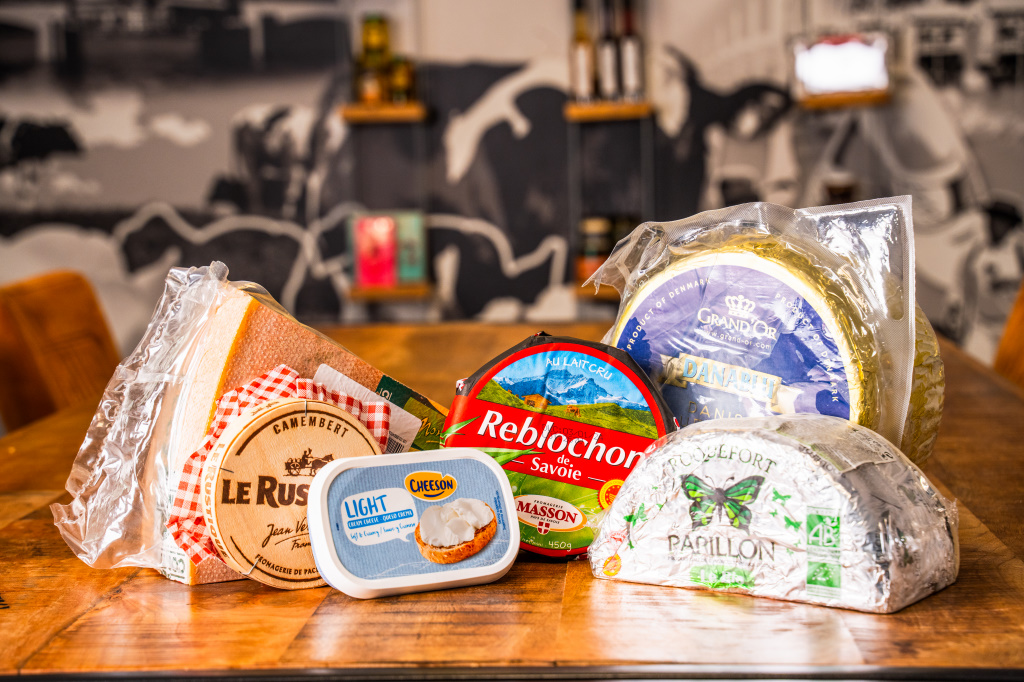Most famous European cheeses
The Middle East loves European cheeses. This is also evident from EU research. For years, the tons of cheese being imported has increased. The best-known European cheeses in the Middle East are Camembert and Brie. In addition, the demand for Fourme d’Ambert, Bleu d’Auvergne and Comté is increasing. A good time to tell you more about Brie, Bleu d’Auvergne and Comté.
What are these dairy products made of? What characterizes the taste of these European cheeses? And why does the Middle East love these products so much? We will tell you about it in this blog.
Characteristic flavors
Meet the three best-known European cheeses in the Middle East.
Brie
Brie is a white mould cheese made from raw milk. The moldy crust is edible and the combination of the flavorful crust with the creamy inside gives the ultimate Brie experience.
In 1815, Austrian statesman Metternich tasted a piece of Brie from Meaux. He was so impressed with the taste that he called it “The King of Cheeses. Since then, Brie has become so popularly known.
In Europe, we know two types of Brie with AOP status. This label guarantees not only the quality but also the geographical origin of the cheese. Both cheeses originate near Paris, near the cities of Melun and Meaux, respectively.
Although both types of Brie come from nearly the same region, they differ greatly in terms of availability, shape and taste.
Brie de Melun has no large production. This makes the Brie exclusive and hard to find. Brie de Meaux is a much more common cheese, readily available at the better Dutch and French cheese shops.
The wheel of Brie de Melun has a diameter of 27 cm, where the wheel of a Brie de Meaux is 35 cm. In addition, a Brie de Meaux has a white and even surface, where a Brie de Melun has yellow-brown spots. Once cut, the texture of Brie de Melun is crumbly and creamy, where Brie de Meaux is even and firm to the touch.
In terms of taste, Brie de Melun has a spicy flavor, in which you can recognize aromas of straw and barn. Brie de Meaux has a smooth and creamy taste. In addition, Brie de Melun is a lot saltier than Brie de Meaux.
Blue d’Auvergne
This traditional French blue cheese from Auvergne is made from raw cow’s milk.
In 1855, the cheese got its origin by working the cheese with rye bread, which was left to rest until a mold developed. Today, the cheese is still made in the traditional way, with the characteristic blue veins developing by infecting the cheese with “Penicillium roqueforti fungus”.
The authenticity of this cheese is guaranteed by the label that reads “Syndicat du Véritable Bleu d’Auvergne”.
Blue d’Auvergne is a soft, unpressed blue cow’s milk cheese in a flat round shape. Its taste is best described as salty-spicy. It has a firm texture and tastes nice and mild.
Besides often being served as part of dessert, Blue d’Auvergne is also extremely suitable as a sauce for a nice pasta dish, for example. The versatility of this cheese represents its success.
Comté
This French hard cheese is made from raw milk and has a piquant flavor with nutty notes. Comté comes from several villages in the mountainous region of France’s Jura Mountains.
Along with Brie de Melun and Brie de Meaux, Comté is one of forty-four French cheeses that bears the red and yellow AOP label.
Comté has been made in small cheese dairies for centuries. Its character is distinctive and unique. Yet every Comté tastes different. This is due to the fact that different microclimates underlie this cheese. For example, the seasons, the cellar where the cheese matures and the cheesemaker’s signature influence the taste of the cheese.
The cheese is naturally very creamy and melts well when heated. This makes Comté perfect for cooking. In addition, this French hard cheese does not look out of place on a beautiful cheese board.
Why the Middle East loves these cheeses

For several years now, the consumption of French cheeses has been increasing in the Middle East. This is mainly due to the fact that both hotels and consumers are increasingly choosing these products when preparing their culinary dishes. The driving force behind this is mostly tourism, which increases the demand for European products.
Not only should products be of high quality, but it should also be clear what their origin is. Knowing what you are eating is thus becoming increasingly important in Middle Eastern countries. Because many producers of European cheeses are transparent about their products from development to store shelves, this is increasingly raising the interests of customers in the Gulf countries.
Therefore, we believe that Brie, Bleu d’Auvergne and Comté will only face more competition from other European cheeses in the coming years.
Tastes like more
Now you understand which three cheeses are best known in the Middle East, what their flavor profile is and what they are made of. Would you like to know more about these French delicacies or perhaps you are curious about the possibilities of working together. Then please get in touch with Robert Lesmeister.